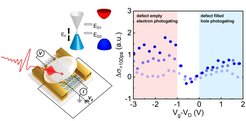Reversible Electrical Control of Interfacial Charge Flow across van der Waals Interfaces
A study on van der Waals heterostructures unveils that the photoinduced processes at the interface between the different materials can be modified by electrically controlling the occupancy of the interfacial defects. The findings are just published in Nano Letters.
Atomically thin materials can be stacked one on top of the other to form novel heterostructures, which exhibit exotic optical and electronic properties that are relevant to various optoelectronic applications, including photodetection. At the interface, the different materials are coupled by van der Waals forces and these interactions lead to an interfacial flow of charge carriers. Understanding and controlling the interfacial charge flow is key to the design of new devices, their operation, and their optimization to specific purposes.

Particularly interesting for their light-matter interaction properties and their high charge carrier mobility are the graphene-transition metal dichalcogenide heterostructures. Photoinduced processes at the interface between the two materials can be investigated by means of an experimental technique called pump probe spectroscopy, which uses ultrashort laser pulses to study ultrafast electronic dynamics.
In a work recently published in the ACS journal Nano Letters, a team of researchers –from the Max Planck Institute for Polymer Research, the Catalan Institute of Nanoscience and Nanotechnology and the University of Mons— used operando optical-pump terahertz-probe spectroscopy to track and control the charge flow at the van der Waals interface between graphene and the transition metal dichalcogenide (TMD). This study revealed not only the fundamental role played by the material defects at the interface (which introduce extra electronic states) in the photoinduced behaviour of the heterostructure, but also –and more importantly– that the latter can be tuned by electrically controlling the occupancy of the interfacial defects.
This work provides important insights into the complex dynamics of interfacial charge carriers in van der Waals heterostructures and into how to reversibly modify it. Such relevant knowhow opens the way to the development of novel high-performance optoelectronic devices by defect and doping engineering of multi-layer heteromaterials.












